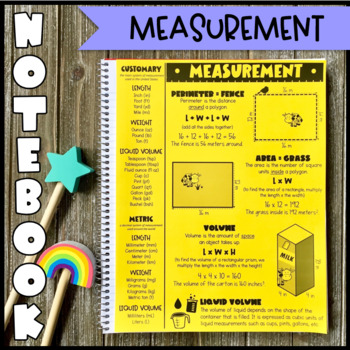Math Notebook: Measurement - Perimeter, Area, and Volume (Personal Anchor Chart)
- Zip
What educators are saying
Also included in
- This resource includes all of my 5th grade personal anchor charts and more will be added as I create them! These helpful pages will be a welcome addition to fifth grade math notebooks and binders. My students also posted them in their work area at home during remote learning. Parents will appreciatePrice $23.99Original Price $28.00Save $4.01
Description
This cheat sheet will come in handy as you introduce or review measurement. This notebook page includes metric and customary measurement abbreviations, the area/perimeter formulas, and volume calculations for rectangular prisms.
This page will be a helpful addition to fifth grade math notebooks and binders. Parents will appreciate having an explanation of the CCSS geometry standard as homework help as well.
Notebook Pages fit:
- 8.5 x 11" spiral notebooks and binders
- smaller notebooks and composition books - printing instructions included
- PDF and PPTX files included
STANDARDS:
Solve problems involving measurement and conversion of measurements.
CCSS.MATH.CONTENT.4.MD.A.1
Know relative sizes of measurement units within one system of units including km, m, cm; kg, g; lb, oz.; l, ml; hr, min, sec. Within a single system of measurement, express measurements in a larger unit in terms of a smaller unit.
CCSS.MATH.CONTENT.4.MD.A.3
Apply the area and perimeter formulas for rectangles in real world and mathematical problems. For example, find the width of a rectangular room given the area of the flooring and the length, by viewing the area formula as a multiplication equation with an unknown factor.
Geometric measurement: understand concepts of volume.
CCSS.MATH.CONTENT.5.MD.C.3
Recognize volume as an attribute of solid figures and understand concepts of volume measurement.
CCSS.MATH.CONTENT.5.MD.C.5
Relate volume to the operations of multiplication and addition and solve real world and mathematical problems involving volume.
CCSS.MATH.CONTENT.5.MD.C.5.A
Find the volume of a right rectangular prism with whole-number side lengths by packing it with unit cubes, and show that the volume is the same as would be found by multiplying the edge lengths, equivalently by multiplying the height by the area of the base. Represent threefold whole-number products as volumes, e.g., to represent the associative property of multiplication.
CCSS.MATH.CONTENT.5.MD.C.5.B
Apply the formulas V = l × w × h and V = b × h for rectangular prisms to find volumes of right rectangular prisms with whole-number edge lengths in the context of solving real world and mathematical problems.
----------------------------------------------------
FONTS USED IN THIS PRODUCT:





